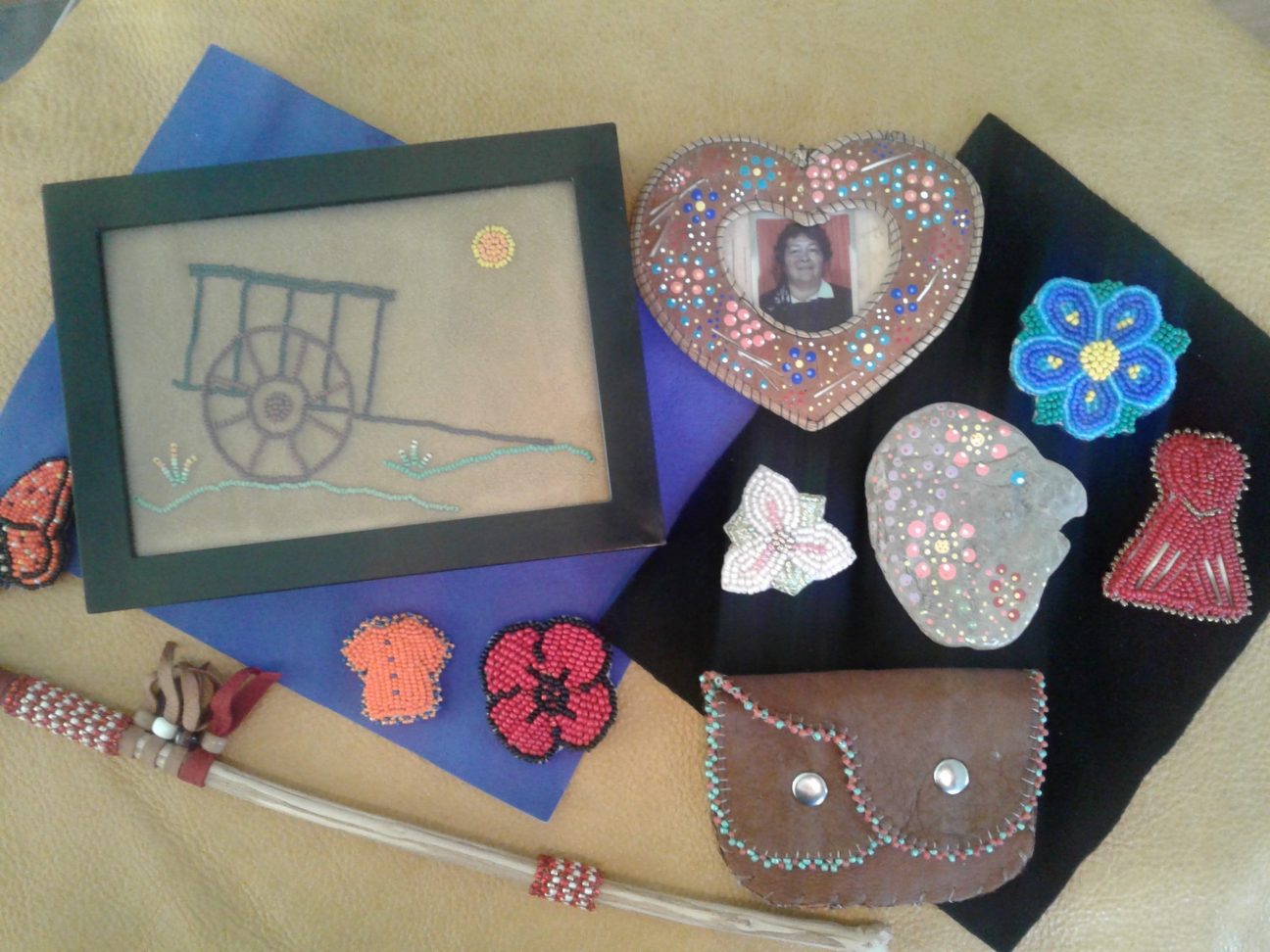It was as if that was the time she was meant to find it. She had everything she needed but never knew until that moment.
Kathy Morgan
Stories told by Kathy Morgan and written by Ashlyn Kerr Sutcliffe
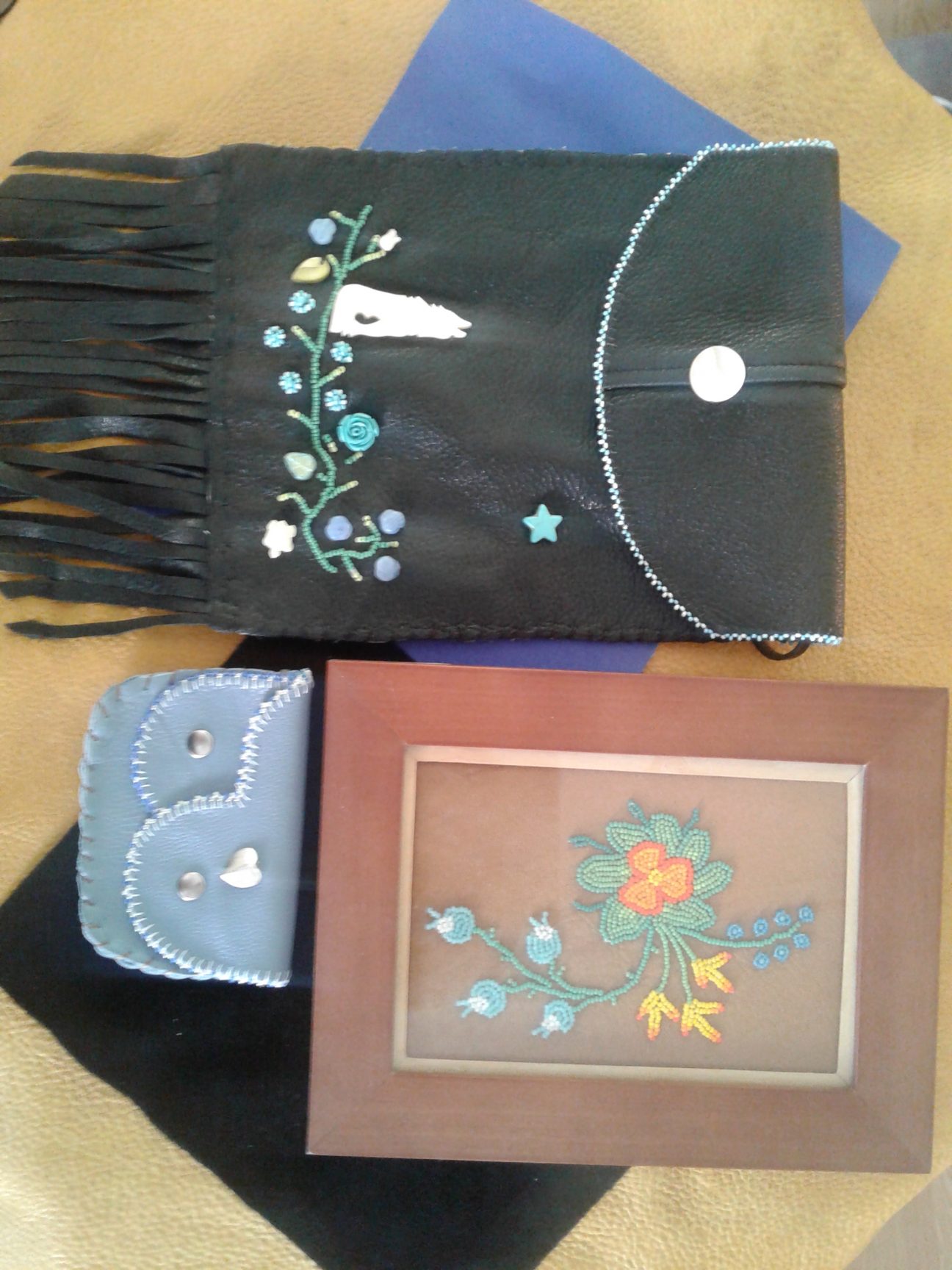
My great-aunt, Kathy Morgan’s Métis heritage, can be traced back to the Red River Settlement and the historical family of Jean Baptiste Lajimodière and Marie-Anne Gaboury. Kathy is a descendant of their youngest son Joseph, whose older sister, Julie, was the mother of Louis Riel. By the mid-19th century, Louis Riel would become a figure of Métis resistance. To Kathy, her Métis identity ties back to the fur trade and the Red River Settlement in Canada, and her connection to the Lajimodières.
Kathy grew up hearing the stories of her family and Métis heritage through conversations with her mother and grandmother. This family history was often told around the kitchen table while card games were played. Kathy’s maternal grandmother was Dene and French, and her grandfather was Cree, French, and Scottish. Kathy heard these stories about her family and their importance to Canadian history. Although she was openly told the history of their Métis heritage, Kathy was told to keep this a secret. She was told not to share her family story with people at school or work.
Kathy’s Childhood
As a child, Kathy grew up knowing her family heritage and ties to being Métis. When she was in grade 5, she remembers going through her history textbook and seeing Louis Riel, pointing to her friend and saying with pride that he was one of her ancestors. That pride quickly turned to shame and confusion when she read further and found that Louis Riel was considered a traitor to Canada. As a 10-year-old, Kathy did not know what to think. On one hand, her family was expressing great pride in being related to Louis Riel, a leader of the Métis Nation. However, on the other hand, she was learning in school that he was a rebel, committing treason against Canada. One day, Kathy brought the textbook home to her mother to figure out why it said something completely different from what she was taught at home. Her mother took the book, walked into her bedroom, and shut the door. After about an hour of being in her room, Kathy’s mother came back into the hall, where she found Kathy. Her mother told her that she could read the textbook and answer all the questions, but she should never believe what was written. Kathy felt shame and didn’t know what to believe. All of her childhood, she was proud to be Métis and proud of her connection to Louis Riel, but in the history books, he was seen as a traitor, and from what she was being taught, therefore all Métis people are traitors.
Growing up, Kathy had parts of Indigenous culture embedded in her life without realizing that these things were Indigenous. She recalls growing up and eating steak with strawberry jam.
When she met my uncle Bill, he was confused when she ordered a steak and asked the restaurant for some jam on the side. Kathy also says she had pemmican in the fridge growing up, but her mom never told her what it was called. She would instead say, “It’s good, just eat it.” Kathy didn’t learn that this food she grew up eating was pemmican until much later on in her life.
High School and The Rebellious Years
My aunt Kathy recalls her teenage years as a time of rebellion and that she never did well in school. In grade 9, she failed 5 of her subjects, requiring her to retake them the following year.
A significant memory in my auntie’s life was when she was in grade 10 history class. Her teacher assigned the class a project on Canada and required it to be 100% Canadian. Kathy remembers thinking back to her history textbook from childhood, thinking to herself, “What does he know about Canada?” The history textbooks and curriculum that she remembered were inaccurate and came from a biased, colonial interpretation of the history of Canada. The night before the project was due, Kathy was sitting in front of the TV with her family’s handmade loom on her lap. Surrounding her was several finished beaded projects, and she was working on another one. Kathy was frustrated with this history project and was angry at what people thought Canada’s history was when she knew it was something different. Then it dawned on her, “If he wants Canada, I’ll give him Canada.” Kathy grabbed a shopping bag and threw all of her beaded projects with the loom included into the bag. When she got to school the next day, she placed all of her beaded work onto her spot for the presentation and sat down. She remembers the teacher coming into the classroom, taking in what is at her station, and leaving the room. Kathy was nervous and a bit scared when the teacher left the room. When the teacher came back, the principal, vice-principal, and other teachers were all by his side. The teacher asked who’s work was at that station, the class all pointed to Kathy, and then, he smiled. Kathy was shocked. She expected a negative response, a reaction of anger, but instead, she got a completely different reaction. That was the first A+ she ever got. When she recalls this story, she acknowledges the significance it had to her life, even stating, “That was a turning point for me.”
Around her teenage years, my aunt Kathy was a rebellious teenager who was not interested in hearing stories of her grandmother or mother. She would say, “Write it down.”
Eventually, Kathy dropped out of high school and started working jobs here and there. She worked as a file clerk and then worked at a T-shirt store putting decals on shirts. At 17, she became interested in a guy working at the T-shirt store, and they began dating. He knew a woman who worked in group homes for Children’s Aid, so he introduced her to Kathy, and they became friends. Kathy recalls moments from her life that were significant to her, one of which was the trip to the flea market in Stouffville with Children’s Aid. When they got to the flea market, Kathy was told to stay with a girl named Kitten, and the two of them went around the market the whole day. Later, her friend was shocked when she found out Kathy and Kitten spent the day together. Kitten was 12 years old, a prostitute, and would run away from anyone who was left to observe her.
When Kathy was 19 years old, she wanted to apply for college, but to do so, she had to be 21 years old to apply for college without a high school diploma. If she had Métis status, the government would help pay for education. She went to Saskatchewan to talk to her grandma and listen to the stories of her family history. Kathy’s grandmother said the words that started Kathy’s journey to discovering her identity: “Do it on your own.” Her grandmother didn’t have status because she wanted to be able to vote, and at that time if you had status you were not allowed to vote.
Holland
Another moment that had a substantial impact on Kathy occurred when she went to Europe for 6 months. Her uncle, Harold Lajimodière, fought in the Liberation of Holland. Kathy received a letter from her uncle asking her to go to Holland. In his letter, there were a couple of landmarks to look for when she was there. Kathy and her friend were confused because they were only told to look for a tree, a hill, and a river to the east. They were in a coffee shop talking about the letter and the broad description of landmarks to look for when 2 men said they knew what her uncle was referring to. The men took them to the place, which turned out to be the cemetery for Canadian soldiers and where Canadians had their camp in Holland. The area had also been turned into a Canadian war museum, and when they got there, they spoke to the director, who gave them a personal tour after Kathy told him who her uncle was. She recalls the director saying to her, “Tell your uncle, ‘thank you for coming.’” At the museum, 12 postcards could come together and make the model of the Canadian camp, which she sent to her uncle in Saskatchewan. That event was impactful to Kathy’s journey because it gave insight into her family member, Harold Lajimodière, and the things he accomplished in his life.
The Reunion
Kathy’s story includes many steps towards learning about her ancestry and her Métis family. One of the most impactful moments in her journey includes the Lajimodière family reunion. In 2006, the Globe and Mail wrote an article about the first family in the west, the Lajimodière’s, and the family reunion being held. When Kathy found out about the reunion from her sister, she was torn because she had already planned a camping trip the same weekend as the reunion. She thought about it for a while.
“What would my mother do? She would go.”
For Kathy to attend the reunion, she would have to trace back how she was related to the Lajimodières. Kathy is related to Joseph, the youngest son of the Lajimodière’s, so she called the number in the article to notify them that she would be coming to the reunion. She found out that the rest of the Lajimodière family had lost track of Joseph’s descendants. When she and my uncle Bill went west for the family reunion, Kathy noticed a picture at the reception area in the school where the reunion was being held. That same picture at the reunion was the same picture under the stairs in her mother’s photo album. “I knew I had to be here,” she thought to herself. That was the reawakening for Kathy and her journey towards learning about her Métis background.
The Magazine
One day, Kathy was walking around Shoppers Drug Mart when she noticed a Canadian Geographic magazine that had, on the cover, an Indigenous woman smiling. She saw the joy in that woman’s face and was inclined to purchase it. It wasn’t until she got back to her house that she realized that magazine had everything she would need to connect the pieces of her Métis ancestry. Kathy opened the magazine to find an article about the Lajimodière legacy and an image of a woman holding the Lajimodière book. Up until that moment, there was information about Kathy’s ancestors and things that could tie her to the Lajimodières. But, she could not use it to claim her status because the Lajimodière book was a privately published book. However, because that image of a woman holding the book was published in National Geographic, it was now considered public record. Kathy had so much information about the Lajimodières and her connection to the family, but some pieces were missing. There was nothing linking her grandfather and his father, which meant she was still unable to claim status with the information she had so far. Kathy spoke about her trip out west to one of her coworkers and the issue that she was unable to find the missing pieces of information that she needed. Her coworker said, “Greg does genealogy as a hobby.” Greg, their other coworker, was excited to have something to look up. Kathy did not know much about her grandmother’s side of the family because her grandma only ever talked about her grandfather. Greg found the 1900 census in North Dakota that listed Modeste as the head of household, Emelie McDougall as his wife, and Albert as their son. Based on this information, Kathy could finally connect the link between her grandfather and great-grandfather with proof. Her great-grandfather was Modeste Lajimodière, and his son was Albert, Kathy’s mother’s father.

Kathy had a copy of the Lajimodière book, and she would use it when working with foster parents to teach them about Métis culture and history in Canada. She got so frustrated when she could not figure out pieces of information that she shook the Lajimodière book, and papers started falling out. Christmas cards, napkins, all with Kathy’s mother’s handwriting. Whenever her mother thought of something, she would write it down anywhere she could, and they were tucked away in the book. Kathy has a needlepoint of Marie-Anne Gaboury that was made by her uncle. On the back of the needlepoint in Kathy’s mother’s handwriting is the lineage of the family. She had had this needlepoint for years, but it wasn’t until that point that she found the lineage that was written on the back. It was as if that was the time she was meant to find it. She had everything she needed but never knew until that moment.
Pioneer Village
Kathy went to Pioneer Village for a Métis rendezvous where she saw women drumming and singing. She could have sat there and listened to the drumming all day. After their performance, Kathy spoke to one of the women named Virginia. She asked Virginia about her journey as a Métis woman and how to go about discovering her identity. The response she got stuck with her, “You have everything you need.” After talking for longer, the two discovered that Kathy’s great great great grandfather and Virginia’s great great great grandfather were friends at the trading post at the Red River Settlement, which is present-day Winnipeg. Ten years later, Kathy is now a part of a drumming group and is passionate about the songs and music they play. She told her story of Pioneer Village to her drumming group and found that the group she is a part of was the same group that inspired her a decade earlier.
Towards the end of our conversation, my Aunt Kathy reflected on her experience as an Indigenous person. She told me that she is 65 years old, saying that she didn’t think she would make it this far, but my uncle Bill saved her from self-destruction. She talks about the racism she, as well as her family, experienced throughout life. Kathy went west to work at the Calgary Stampede, and after she was no longer needed for the job, she went to look for other work. Nobody was hiring her. One day she had an interview with a guy for jobs very similar to the work she had experience doing. She asked him why he won’t hire her because she had the experience, she could do the job, but he wouldn’t hire her. All he said was, “Look in the mirror.” She didn’t understand what he meant, and then it dawned on her. She thought, “It’s not what I know, it’s how I look.”
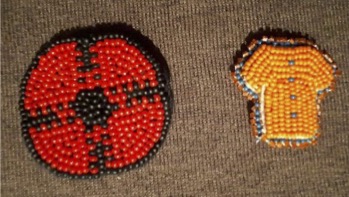
Kathy said there was a lot of confusion in her life because of the contrast between what she learned from her family and what she learned in school. She was told stories about Métis pride and Louis Riel from her grandma and mother but then was told stories about how the Métis were traitors in school. By the age of 10, Kathy was being taught that she should be ashamed of her identity. This is so different from how I view my Aunt Kathy, and I am glad she has a sense of pride now. Kathy had the initiative to make the effort and discover the history of her family. Her grandmother said to her “You are the one for our family.”
Métis Festivals and Beaded Flowers
My Aunt Kathy and I are not blood-related, and she is my maternal grandmother’s, brother’s, wife. My grandmother is very open to learning about cultures and religions, and she tries to give her grandchildren the same opportunities. When I was around 10 years old, I attended Métis events, potlucks, and festivals for the first time. I would go to these events with Aunt Kathy, my grandma, and occasionally my cousin. As a young non-Indigenous person, attending these events was a completely different experience than I was used to because there was such a unique culture and sense of community present. I reflect on these moments and experiences with a lot of appreciation and joy for the opportunities because I was able to see a different side of Indigenous culture than other non-Indigenous children my age. I cannot remember how many of these festivals and potlucks I attended. Whether it was 1 or 10, I know that it impacted me in such a positive way. I was able to see the pride in everyone there and authentically learn about Métis culture. I remember seeing the Métis flag, people wearing the Métis sash, a young boy playing the fiddle, and various foods I had never tried before. I believe one of the reasons I chose to study Indigenous Studies was because of these experiences I had when I was younger.
My Aunt Kathy exposed me to another aspect of Indigenous peoples and culture that was not being taught in schools; At that time, we were learning about colonization and the genocide of Indigenous peoples through the spread of diseases and starvation. Children who were only 8, 9, or 10 years old were receiving this information from a colonial view, and it was almost like Indigenous people were extinct, something of the past. I remember learning about Indigenous people as one group rather than various cultures, traditions, and identities. I do not think I learned about the Métis in elementary school. It wasn’t until I was in high school that I began to learn about the differences between many different Indigenous groups in Canada and their unique traditions and history.
Aunt Kathy is also a wonderful beader, and she has made several beaded pieces for members of my family. The most significant pieces are the beaded purse and coin purse she gifted to me. The purses are made out of an animal hide, and each has a pinkish-red and white flower beaded on the front. The larger of the two was given to me first, and I believe I got the coin purse a couple of years later. I remember bringing my purse to school when I was in the third grade and showing it off to the other students. I was so excited to show people the pretty flower that my Aunt Kathy had beaded, telling people she was Métis and that she had made me a beautiful purse. The other kids didn’t understand my excitement, but I still have those purses and will keep them if I eventually have kids. When I have children, I hope that they will be able to have similar experiences to me when I was younger, as I think it was a big part of my growth and understanding of Indigenous culture.
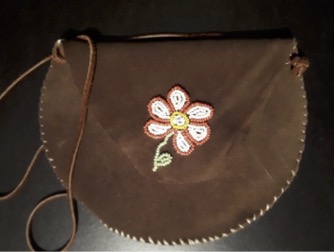
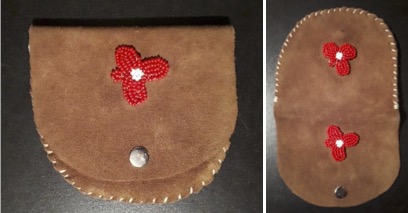
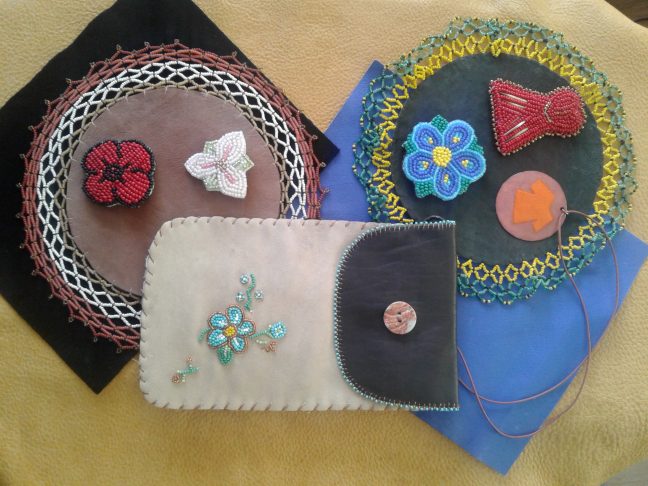
I am glad that my Aunt Kathy was able to find her sense of self and embrace her Métis identity. I met with her to listen to her story, and I was so happy she wanted to sit down and talk to me. I loved listening and learning about the Lajimodières and the history of the family because it was something I had never learned in school. My Aunt Kathy has impacted my life greatly. I truly value her, all the knowledge she has given me, and the experiences I have had.
“You are the one for our family”

